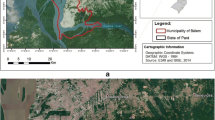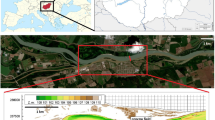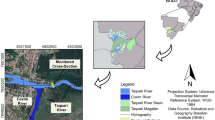Abstract
Suspended sediment distribution and fluxes were estimated within the dominant channel at the mouth of the Rhone River for two annual flood events. The estimates were based on ADCP acoustic backscatter intensity and using calibration and post-processing methods to account for the grain-size distribution (GSDs). The fluxes were very similar to those obtained from suspended sediment measurements based on surface sampling at an automated station located 35 km upstream. Suspended sediment concentrations (SSC) and GSDs showed little variation along the channel cross-section, except for a graduate suspension that appeared at the maximum of discharge, corresponding to velocities lower than 1 m s−1 near the bottom. However, without post processing to account for the GSD, an under-estimation of 10% was observed during the two flood periods. The two flood events (12 November 2012 and 29 November 2012), separated by only 2 weeks, had clear differences in suspended sediment fluxes (SSF) and SSC during the peak of the river discharge, with twice more flux during the first, respectively, 925,226 and 430,879 tons of SSF.









Similar content being viewed by others
References
Alvarez, L. G., & Jones, S. E. (2002). Factors influencing suspended sediment flux in the Upper Gulf of California. Estuarine, Coastal and Shelf Science, 54, 747–759.
Antonelli, C., Provansal, M., & Vella, C. (2004). Recent morphological changes of a channel in deltaïc environment. The case of the Rhône River, France. Geomorphology, 57, 385–402.
Antonelli, C., Eyrolle, F., Rolland, B., Provansal, M., & Sabatier, F. (2008). Suspended sediment and 137Cs fluxes during the exceptional December 2003 flood in the Rhone River, southeast France. Geomorphology, 95, 350–360.
Arnaud-Fassetta, G., Quisserne, D., & Antonelli, C. (2003). Downstream grain-size distribution of surficial bed material and its hydro-geomorphological significance in a large and regulated river: the Rhône River in its delta area (France) (Vol. 9, pp. 33–49). Géomorphologie.
Blum, M., & Tornqvist, T. E. (2000). Fluvial response to climate and sea-level changes: a review and lookforward. Sedimentology, 47, 2–48.
Boateng, I., Bray, M., & Hooke, J. (2012). Estimating the fluvial sediment input to the coastal sediment budget: a case study of Ghana. Geomorphology, 138, 100–110.
Boudet, L., Sabatier, F., & Radakovitch, O. (2017). Modelling of sediment transport pattern in the mouth of the Rhone delta: role of storm and flood events. Estuarine, Coastal and Shelf Science, 198, part B, 568–582.
Cutroneo, L., Castellano, M., Pieracci, A., Povero, P., Tucci, S., & Capello, M. (2012). The use of a combined monitoring system for following a turbid plume generated by dredging activity in a port. Journal of Soils and Sediments, 12, 797–809.
Defendi, V., Kovačević, V., Arena, F., & Zaggia, L. (2010). Estimating sediment transport from acoustic measurements in the Venice Lagoon inlets. Continental Shelf Research, 30, 883–893.
Dredging Research Ltd. (2003). The Sediview method. In Sediview procedure manual. Godalming: DRL Software Ltd. 83pp.
Duclos, P. A., Lafite, R., Le Bot, S., Rivoalen, F., & Cuvillier, A. (2013). Dynamics of turbid plumes generated by marine aggregate dredging: an example of a macrotidal environment (the Bay of Seine, France). Journal of Coastal Research, 29(6a), 25–37.
Eyrolle, F., Radakovitch, O., Raimbault, P., Charmasson, S., Antonelli, C., Ferrand, E., Aubert, D., Raccasi, G., Jacquet, S., & Gurriaran, R. (2012). Consequences of hydrological events on the delivery of suspended sediment and associated radionuclides from the Rhône River to the Mediterranean Sea. Journal of Soils and Sediments, 12, 1479–1495.
Francois, R. E., & Garrison, G. R. (1982). Sound absorption based upon ocean measurement, part II. The Journal of the Acoustical Society of America, 72(6), 1870–1890.
Gartner, J. W. (2004). Estimating suspended solids concentrations from backscatter intensity measured by acoustic Doppler current profiler in San Francisco Bay, California. Marine Geology, 211, 169–187.
Ghaffari, P., Azizpour, J., Noranian, M., Chegini, V., Tavakoli, V., & Shah-Hosseini, M. (2011). Estimating suspended sediment concentrations using a broadband ADCP in Mahshahr tidal channel. Ocean Science Discussions, 8, 1601–1630.
Guerrero, M., Szupiany, R. N., & Amsler, M. (2011). Comparison of acoustic backscaterring techniques for suspended sediment investigations. Flow Measurement and Instrumentation, 22, 392–401.
Holdaway, G. P., Thorne, P. D., Flatt, D., Jones, S. E., & Prandle, D. (1999). Comparison between ADCP and transmissometer measurements of suspended sediment concentration. Continental Shelf Research, 19(3), 421–441.
Horowitz, A. J. (2008). Determining annual suspended sediment and sediment-associated trace element and nutrient fluxes. Science of the Total Environment, 400, 315–343.
Horowitz, A. J., Clarke, R. T., & Merten, G. H. (2015). The effects of sample scheduling and sample numbers on estimates of the annual fluxes of suspended sediment in fluvial systems. Hydrological Processes, 29, 531–543.
Hu, J., Pan, J., Guo, X., & Zheng, Q. (2011). A summary of special section: regional environmental oceanography in the South China Sea and its adjacent areas (REO-SCS). Journal of Oceanography, 67, 675–676.
Inman, D. L., & Jenkins, S. A. (1999). Climate change and the episodicity of sediment flux of small California Rivers. Journal of Geology, 107, 251–270.
Kostaschuk, R., Best, J., Villard, P., Peakall, J., & Franklin, M. (2005). Measuring flow velocity and sediment transport with an acoustic Doppler current profiler. Geomorphology, 68, 25–37.
Land, J. M., & Bray, R. N. (2000). Acoustic measurement of suspended solids for monitoring of dredging and dredged material disposal. Journal of Dredging Engineering, 2(3), 1–17.
Limber, P. W., Patsch, K. B., & Griggs, G. B. (2008). Coastal sediment budgets and the littoral cutoff diameter: a grain size threshold for quantifying active sediment inputs. Journal of Coastal Research, 24, 122–133.
Meybeck, M., Laroche, L., Dürr, H., & Syvitski, J. P. (2003). Global variability of daily total suspended solids and their fluxes in rivers. Global and Planetary Change, 39, 65–93.
Moatar, F., Person, G., Meybeck, M., Coynel, A., Etcheber, H., & Crouzet, P. (2006). The influence of contrasting suspended particulate matter transport regimes on the bias and precision of flux estimates. Science of the Total Environment, 370, 515–531.
Ollivier, P., Radakovitch, O., & Hamelin, B. (2011). Major and trace partition and fluxes in the Rhone river. Chemical Geology, 285(1-4), 15–31.
Picouet, C., Hingray, B., & Olivry, J. C. (2001). Empirical and conceptual modelling of the suspended sediment dynamics in a large tropical African river: the Upper Niger river basin. Journal of Hydrology, 250, 19–39.
Pont, D., Simonnet, J. P., & Walter, A. V. (2002). Medium-term changes in suspended sediment delivery to the ocean: consequences of catchment heterogeneity and river management (Rhône River, France). Estuarine, Coastal and Shelf Science, 54, 1–18.
Provansal, M., Dufour, S., Sabatier, F., Antony, E., Raccasi, G., & Robresco, S. (2014). The geomorphic evolution and sediment balance of the lower Rhone River (southern France) over the last 130 years: hydropower dams versus other control factors. Geomorphology., 219, 27–41.
Rijn, V. (1993). Principles of sediment transport in rivers, estuaries and coastal seas. Amsterdam: Aqua Publications ISBN 90-800356-2-9 bound NUGI 816/831, 690 p.
Rovira, A., Batalla, R. J., & Sala, M. (2005). Fluvial sediment budget of a Mediterranean river: the lower Tordera (Catalan Coastal Ranges, NE Spain). Catena, 60, 19–42.
Sakho, I., Dupont, J.-P., Cisse, M. T., El Janyani, S., & Loum, S. (2017). Hydrological responses to rainfall variability and dam construction: a case study of the upper Senegal River basin. Environmental Earth Sciences, 76, 1–19. https://doi.org/10.1007/s12665-017-6570-4.
Schoellhamer, D. H., Wright A. S. (2003). Continuous measurement of suspended-sediment discharge in rivers by use of optical backscatterance sensors. Erosion and sediment transport measurement in rivers: technological and methodological advances 1 (Proceedings of the Oslo workshop, June 2002). IAHS Publication 283
Shi, Z. (2010). Tidal resuspension and transport processes of fine sediment within the river plume in the partially-mixed Changjiang estuary, China: a personal perspective. Geomorphology., 121, 133–151.
Syvitski, J., & Saito, Y. (2007). Morphodynamics of deltas under the influence of humans. Global and Planetary Change, 57(3-4), 261–282.
Teledyne, RD Instruments. (2007). WorkHorse Rio Grande acoustic Doppler current profiler. Technical manual P/N 957-6241-00. Poway: Teledyne RD Instruments 254pp.
Tessier, C., Le Hir, P., Lurton, X., & Castaing, P. (2008). Estimation de la matière en suspension à partir de l’intensité rétrodiffusée des courantomètres acoustiques à effet Doppler (ADCP). Comptes Rendus Geoscience, 340, 57–67.
Unverricht, D., Nguyen, T. C., Heinrich, C., Szczuciński, W., Lahajnar, N., & Stattegger, K. (2014). Suspended sediment dynamics during the inter-monsoon season in the subaqueous Mekong Delta and adjacent shelf, southern Vietnam. Journal of Asian Earth Sciences, 79, Part A, 509–519.
Urick, R. J. (1983). Principles of underwater sound. McGraw-Hill Book.
Vörösmarty, C., Meybeck, M., Fekete, B., Sharma, K., Green, P., & Syvitski, J. P. M. (2003). Anthropogenic sediment retention: major global-scale impact from the population of registered impoundments. Global and Planetary Change, 39, 169–190.
Walling, D. E., Webb, D. W., & Woodward, J. C. (1992). Some sampling considerations in the design of effective strategies for monitoring sediment-associated transport. IAHS Publication, 210, 279–288.
Zebracki, M., Eyrolle-Boyer, F., Evrard, O., Claval, D., Mourier, B., Gairoard, S., Cagant, X., & Antonelli, C. (2015). Tracing the origin of suspended sediment in a large Mediterranean river by combining continuous river monitoring and measurement of artificial and natural radionuclides. Science of the Total Environment, 502, 122–132.
Acknowledgments
The authors are very grateful to the Syndicat Mixte d’Aménagement des Digues du Delta du Rhône et de la Mer for the help.
Funding
This work was funded by the Regional Council of Bouches-du-Rhone and Rhone Sediment Observatory which is funded by the CNR, EDF, Agence de l’Eau RMC and PACA, Rhone, and Languedoc-Roussillon regional councils.
Author information
Authors and Affiliations
Corresponding authors
Additional information
Publisher’s note
Springer Nature remains neutral with regard to jurisdictional claims in published maps and institutional affiliations.
Rights and permissions
About this article
Cite this article
Sakho, I., Dussouillez, P., Delanghe, D. et al. Suspended sediment flux at the Rhone River mouth (France) based on ADCP measurements during flood events. Environ Monit Assess 191, 508 (2019). https://doi.org/10.1007/s10661-019-7605-y
Received:
Accepted:
Published:
DOI: https://doi.org/10.1007/s10661-019-7605-y




